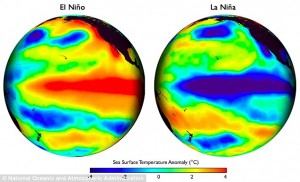The 1997-1998 El Nino is estimated to have caused over 23,000 deaths worldwide. (source). With forecasters saying that the signs point to an 80% chance of a strong El Nino forming towards the end of this years, what impacts can be expected?
While some areas, such as the West Coast of the United States could get a massive amount of rain, very welcome after record breaking droughts, other areas, that rely on rain for agriculture, will be left bone dry. A strong El Niño also increases fears that production of many key agricultural commodities in Asia and Australia will suffer.
Extreme El Niño events develop differently from standard El Niños, which first appear in the western Pacific. The extreme events occur when sea surface temperatures exceeding 28°C develop in the normally cold and dry eastern equatorial Pacific Ocean. This different location for the origin of the temperature increase causes massive changes in global rainfall patterns, which result in floods and torrential rain in some places and devastating droughts and wildfires in others.
Kevin Trenberth, a climate scientist at the National Center for Atmospheric Research in Boulder, Colorado, says the coming event could rival the one from 1997. He has been monitoring sea levels with satellite altimetry data and has noticed about a 20-centimeter difference between the western and eastern tropical Pacific.
In the past 15 years, Trenberth says, winds associated with La Niña—El Niño’s sister effect—have piled up warm water in the western Pacific, near the Philippines. Those winds have largely collapsed this year, and so those waters are moving back east. “It’s been waiting to slop back, and is now doing so, and will be very hard to stop,” he says. He also points out that NOAA based its prediction mostly on data from April—and says more recent data show strong signs that waters off the coast of Peru are continuing to warm. “I don’t think we’ve seen anything like this before,” he says.(source)
If the El Nino does arrive you can expect food prices to riser even faster than they are at present. Large swathes of agricultural land, land that currently supplies everything from fruit and vegetables to grains and cattle will suffer from the massive weather variations that El Nino brings.
Drought and floods will take their toll in areas that are often not well equipped to deal with weather that is the opposite of what they usually experience. As the months roll on the predictions will become more precise, but the 80% certainty stated by many forecasters and scientists indicates that our current weather patterns may well be about to change.
This article was originally published at Ready Nutrition™ on May 22nd, 2014







